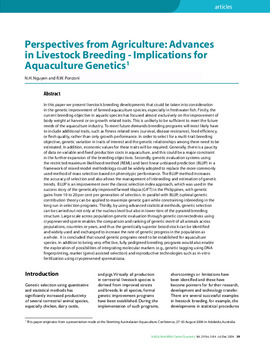Perspectives from Agriculture: Advances in livestock breeding-Implications for aquaculture genetics
Abstract
In this paper we present livestock breeding developments that could be taken into consideration in the genetic improvement of farmed aquaculture species, especially in freshwater fish. Firstly, the current breeding objective in aquatic species has focused almost exclusively on the improvement of body weight at harvest or on growth related traits. This is unlikely to be sufficient to meet the future needs of the aquaculture industry. To meet future demands breeding programs will most likely have to include additional traits, such as fitness related ones (survival, disease resistance), feed efficiency, or flesh quality, rather than only growth performance. In order to select for a multi-trait breeding objective, genetic variation in traits of interest and the genetic relationships among them need to be estimated. In addition, economic values for these traits will be required. Generally, there is a paucity of data on variable and fixed production costs in aquaculture, and this could be a major constraint in the further expansion of the breeding objectives. Secondly, genetic evaluation systems using the restricted maximum likelihood method (REML) and best linear unbiased prediction (BLUP) in a framework of mixed model methodology could be widely adopted to replace the more commonly used method of mass selection based on phenotypic performance. The BLUP method increases the accuracy of selection and also allows the management of inbreeding and estimation of genetic trends. BLUP is an improvement over the classic selection index approach, which was used in the success story of the genetically improved farmed tilapia (GIFT) in the Philippines, with genetic gains from 10 to 20 per cent per generation of selection. In parallel with BLUP, optimal genetic contribution theory can be applied to maximize genetic gain while constraining inbreeding in the long run in selection programs. Thirdly, by using advanced statistical methods, genetic selection can be carried out not only at the nucleus level but also in lower tiers of the pyramid breeding structure. Large scale across population genetic evaluation through genetic connectedness using cryopreserved sperm enables the comparison and ranking of genetic merit of all animals across populations, countries or years, and thus the genetically superior brood stock can be identified and widely used and exchanged to increase the rate of genetic progress in the population as a whole. It is concluded that sound genetic programs need to be established for aquaculture species. In addition to being very effective, fully pedigreed breeding programs would also enable the exploration of possibilities of integrating molecular markers (e.g., genetic tagging using DNA fingerprinting, marker (gene) assisted selection) and reproductive technologies such as in-vitro fertilization using cryopreserved spermatozoa

